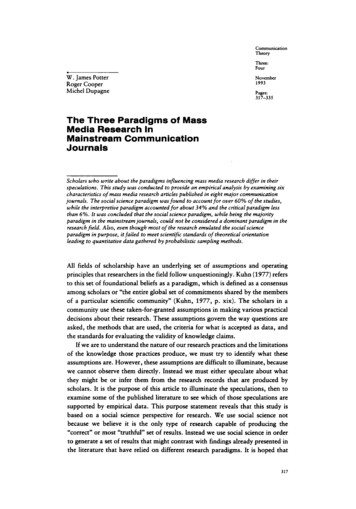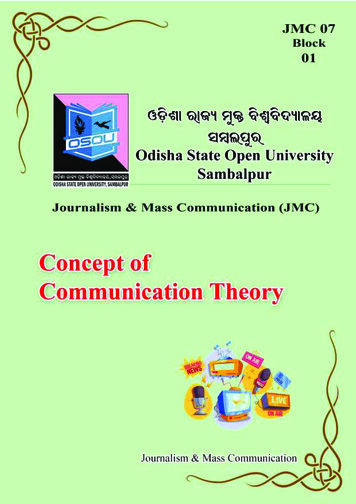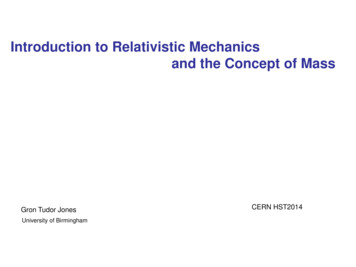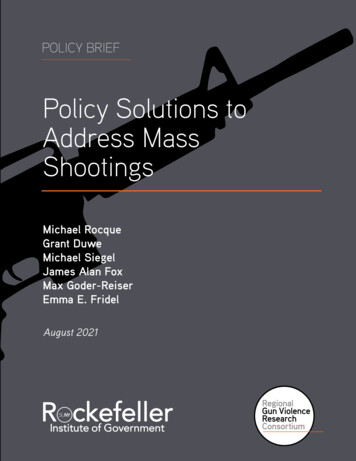
Transcription
CommunicationTheoryThree:Four.W James PotterRoger CooperMichel DupagneNovember1993Pages:317-335The Three Paradigms of MassMedia Research InMainstream CommunicationJournalsScholars who write about the paradigms influencing mass media research differ in theirspeculations. This study was conducted to provide an empirical analysis by examining sixcharacteristics of mass media research articles published in eight major communicationjournals. The social science paradigm was found to account for over 60% of the studies,while the interpretive paradigm accounted f o r about 34% and the critical paradigm lessthan 6%. I t was concluded that the social science paradigm, while being the majorityparadigm in the mainstream journals, could not be considered a dominant paradigm in theresearch field. Also, even though most of the research emulated the social scienceparadigm in purpose, it failed to meet scientific standards of theoretical orientationleading to quantitative data gathered by probabilistic sampling methods.All fields of scholarship have an underlying set of assumptions and operatingprinciples that researchers in the field follow unquestioningly. Kuhn (1977)refersto this set of foundational beliefs as a paradigm, which is defined as a consensusamong scholars or “the entire global set of commitments shared by the membersof a particular scientific community” (Kuhn, 1977, p. xix). The scholars in acommunity use these taken-for-granted assumptions in making various practicaldecisions about their research. These assumptions govern the way questions areasked, the methods that are used, the criteria for what is accepted as data, andthe standards for evaluating the validity of knowledge claims.If we are to understand the nature of our research practices and the limitationsof the knowledge those practices produce, we must try to identify what theseassumptions are. However ,these assumptions are difficult to illuminate, becausewe cannot observe them directly. Instead we must either speculate about whatthey might be or infer them from the research records that are produced byscholars. It is the purpose of this article to illuminate the speculations, then toexamine some of the published literature to see which of those speculations aresupported by empirical data. This purpose statement reveals that this study isbased on a social science perspective for research. We use social science notbecause we believe it is the only type of research capable of producing the“correct” or most “truthful” set of results. Instead we use social science in orderto generate a set of results that might contrast with findings already presented inthe literature that have relied on different research paradigms. It is hoped that317
CommunicationTheoryreaders will consider the conclusions of all types of studies when thinking aboutthe paradigms that underlie mass media research.SpeculatlonsThere is a good deal of speculation about the sets of assumptions or paradigmsin various fields of social science. For example, sociology as a research disciplineis regarded as a parent of media research in terms of providing research methods,questions, and theories. But sociology is not a unified social science, that is, notall sociologists use the same methods or ask the same types of questions. Thereis considerable variety in perspectives among sociologists concerning what theysee as the purpose of the research in their field. And furthermore, scholars whospeculate on the paradigms governing sociological research also exhibit a considerable variety of perspectives. There are at least four expressed perspeaiveson paradigm configurations. Friedrichs (1970) believes that sociology has twoparadigms, but other scholars see three (Eisenstadt & Curelaru, 1976; Lemert,1979; Ritzer, 1981).The differences in these four conceptions can be traced to differences in theway these scholars have operationalized the idea of paradigm. Friedrichs focuseshis attention on what sociological researchers believe the essential nature ofsociety to be, and this belief is the fundamental assumption that distinguishesamong sociological scholars. He says that a researcher either regards society a s asystem striving to maintain balance, or as a collection of groups in perpetualconflict. Each of these two groups of scholars ask their research questions in adifferent manner, look for different kinds of evidence requiring differing methodologies, and employ different forms of analysis. Eisenstadt and Curelaru (1976)also build their fundamental distinction on what the researcher believes societyto be. But they see an evolution of three serial paradigms where the first isbased on the view that society is a discrete system (psychological and ecologi.ca1characteristics of people), the second that society is a closed system (composedof separate but interrelated elements or classes of people where one dominatesthe others), and the third that society is an open system (composed of manyinterconnections and continuous feedback processes among the components).Ritzer (1981)draws his distinction by identifying the part of the overall phencimenon of society on which the researcher focuses. Some researchers are mostinterested in social facts (large-scale social structures such as institutions), othersare primarily interested in social definitions (how people define their social situations and how those definitions influence their actions), and still others focus onsocial behavior (how rewards and punishments shape behavior of individuals).And Lemert (1979)makes his categorizations by level of the phenomenon exaimined where there is the lexical level (technical look at language), the semanticallevel (interpretation of meaning of language), and the syntactical (large-scalepolitical interpretation). As can be seen among these sociology scholars, there aresubstantial differences among their views about which paradigms are influencingresearch in their field. These differences in paradigm configurations are based ondifferences in the criteria used to distinguish among research studies.318
Paradigms of Mass Media ResearchParadlgmr In M a r Modla StudlwThere is also a diversity of views about the paradigms underlying mass mediaresearch. There are at least six different speculations. Both Lowery and DeFleur(1988)and Hall (1982) state that there are three sequentiallyordered paradigms;Craig (1989) sees three coexisting ones; Giddens (1989) sees one; and Krippendorff (1989) and Rosengren (1989) each see none. In their review of the milestones of mass media research, Lowery and DeFleur (1988)posit that there havebeen three paradigms in the field. First, there was the mass society paradigmthat was based on the assumption that the audience was composed of a mass ofpeople who passively received media content as if those messages were magicbullets delivering direct, unfiltered effects. Second, there was a shift to a cognitiveparadigm that focused on how sensory input shapes perceptions, beliefs, attitudes, values, memory, thinking, and actions. Then, in the 1970s, a third paradigm emerged where researchers operated under the belief that symbol systems(such as language and media texts) conveyed widely shared meanings about theworld and people’s behaviors. Called the “meaning” paradigm, it stimulatedresearchers to look for evidence of longer-term effects, internal as well as externalto the person.Hall (1982) also has a three-phase perspective on paradigms. Hall, like Lowery and DeFleur, begins with the “mass society” paradigm. He reasons that therise of the urban commercial culture in Europe during the 1700s was perceivedas a threat to the traditional cultural values, and this became a real concernduring the late 1800s when sociologists began to notice a deep and qualitativeshift in social relations among people in many advanced industrial capitalistsocieties. This European approach employed history and philosophy to makesweeping generalizations. Using speculation with some empiricism, these European sociologists regarded the media as having a direct and powerful effect onindividuals. He sees a second paradigm beginning in the 1940s and dominatinginto the 1960s. This American-based paradigm relied more strongly on scientificmethods, focused on the behavioral change of individuals, and followed a Lasswellian research formula of who (control analysis) says what (content analysis)to whom (audience analysis) to what effect (audience effects). The third stagereflects a shift toward ideology and is very critical of social scientific methods ofsurvey, experiment, and reductionistic content analysis. Grounded in linguisticsand structural sociology, this third paradigm regards each culture as having adifferent way of classifying the world. Culture, language, and symbols inducecertain meanings.Craig (1989) speculates that there are three coexisting paradigms in massmedia research: empiricism, which seeks to explain, predict, and control observable phenomena by discovering necessary, general relationships among them;hermeneutics, which seeks to understand meaningful human actions by interpreting texts and locating them within intelligible frames; and critical theory, whichseeks emancipatory social change through critical reflection on social practices.Giddens (1989) views media studies as having a single social scientific paradigm that is characterized by naturalism, social causation, and functionalism.Naturalism (a term he prefers over positivism) is the notion that social sciences319
should be modeled after natural sciences and that the logical framework of socialscience addresses problems similar to those of natural science. Social causation isthe idea that social scientists are able to demonstrate that people are moved bycauses of which they are unaware. Functionalism focuses on systems of behavior,and as such is modeled more after biology than physics. Giddens admits thatthis paradigm is being challenged and that it no longer has a consensus, bui: hedoes not explain what the evolving paradigms are.Krippendorff (1989) says that the field is in a preparadigmatic stage. Heequates this stage with naivety because he sees scholars questing for a naturalisticparadigm but not being able to achieve it because, in his opinion, there is noobjective existence outside of independent, scientific observers, and those obsrrvers are not able to enter the domain of observation, because they believe thatdoing so would taint the phenomena they want to examine.Rosengren (1989) seems to take the most radical approach by saying not onlythat the field of mass media research is without paradigms but that none of thesocial sciences (with the possible exception of economics and linguistics) has aparadigm. But unlike Krippendorff, Rosengren moderates his position by sayingthat scholars have differing research traditions and schools of thought, such asthe critical school and the positivist school. He says that the dominant school isfunctionalist sociology, which regards science as objective and society as consensus or static.It is interesting to note that six schemes can evolve out of the same startingpoint. All acknowledge Kuhn’s conception of a paradigm and all are writingabout the field of media studies, but six different schemes result. How is ,thispossible? The answer seems to lie in the way these scholars translate Kulin’sconception into particular criteria to use in categorizing media research. Loweryand DeFleur use the criteria of research focus in categorizing the research intoparadigms; they show that the focus has shifted from a concentration on effectsand toward the process used by audience members in making meaning fromparticular texts. Hall distinguishes among paradigms primarily in terms of focus(like Lowery and DeFleur) and methodology. As for the latter criterion, heexplains that the latest paradigm shift is a change in focus away from behavioralmethods of survey, experiment, and reductionistic content analysis to textualanalysis. Giddens and Rosengren also use the methodological criterion as doesKrippendorff in explaining his position that the field of mass media studie: ispreparadigmatic. Craig distinguishes among paradigms on the purpose for theresearch. The differences in determining what paradigms exist then can be tralcedin part to whether we highlight differences in the focus of the research, themethods used, or the purpose.The most fundamental criterion (among focus, method, and purpose) is purpose, because it addresses the most deep-seated assumptions of researchers. Media scholars have been debating whether the primary purpose of inquiry shouldbe to explain, interpret, or critique the phenomenon of mass media. This debatewill continue to be unresolved, because it is based on personal values. Whetherthe personal values are a product of training or of a personality-based inclinationto see the world in a certain way, scholars exhibit a dominant mode in the design320
Paradigms of Mass Media Researchof their research. This is not to say that the dominant mode is the only modethat influences that research. For example, a person who defines herself predominately as a social scientist would focus on generating empirical data in an attemptto explain some aspect of the mass media, but she will also critique the findingsand assumptions in the literature and then interpret her findings. In contrast, aperson who defines himself predominately as a critical scholar would be primarily interested in critiquing a media institution, but he must also explain hisideological stance and interpret events for the reader so as to build a convincingcritique.RationaleThis research study is not superparadigmatic, that is, it cannot provide an analysis of paradigms from a platform that is itself not influenced by a paradigm. Theresearch concerning paradigms reviewed above has been conducted from aninterpretive or ideological point of view. In contrast, this study will be conductedwithin a social science type paradigm. If the findings of this study conform tothe conclusions advanced in the articles using another paradigm, then therewill be reason to believe that the phenomenon of interest (i.e., paradigmaticconfiguration in the mass media literature) is indeed robust enough to emerge inthe insights of scholars with very different conceptions of research. If the findingsof this study do not conform to those of other scholars, then the discussion ofparadigmatic differences will need to evolve to a higher level of synthesis.First, a distinction must be made between purpose and the operational elements that researchers use to achieve their purpose. The purpose criterion is themost fundamental to scholarship and has been shown to provide the deepestdivisions among researchers. The operational elements (such as focus of theresearch, use of theory, type of data, etc.) follow from purpose, so examiningthese elements in the research should provide a reflection of the fundamentalpurpose of the study, but not an accurate picture of it. For example, the use ofquantitative data reflects an explanatory purpose, but quantitative data are alsoused by interpretive and critical scholars. Therefore, these operational elementscan be useful in reflecting purpose, but they are not clear enough as discriminators to use in classifying research into paradigms. This argument can be tested inthis study, because two levels of coding are conducted, one at the purpose leveland the other at the operational level. The data from these two analyses will becompared to determine the degree to which the operational elements provide aclean profile of paradigms categorized by purpose.Next, the variables in the two levels of analysis must be defined. At thecategorization level, purpose will be used. At the profile level, the operationalelements will be research focus, use of theory, type of data, source of data, andtype of sample.PurposeThe concept of paradigm must be defined clearly and precisely enough to be auseful guide in analyzing the research; however the concept must not be reductionistic to the point where the results are so atomistic that they cannot be321
CommunicationTheoryassembled into interesting patterns to answer the questions posed. Fortunately,the essays that speculate about paradigms in mass media research provide astrong starting place. Despite the range of views, there is relatively high degreeof conformance on a few points. All, except for Krippendorff, acknowledge thatmass media research has at least one paradigm and probably more than one(although Giddens describes only one and Rosengren calls them schools ofthought). All see a paradigm that variously goes by the name of social science,American behaviorism, positivism, empiricism, or cognitive science. The termspositivism and empiricism are often used as synonyms for social science. Theterms American behaviorism and cognitive science, while not synonyms for socialscience, are clearly major domains within it. The traditional social science perspective focuses on human behavior to make statements about hypothetical constructs such as attitudes, values, beliefs, motivations, intentions, and satisfactions. These researchers use traditional social scientific methodologies ofexperiment, survey, and content analysis to gather data (primarily quantitativebut also qualitative) from individuals (people and programs) to make generalizable statements about human behavior in the aggregate. Finally, all writers whospeculate about paradigms in mass media research, except Krippendorff andGiddens, see a second paradigm under the name of ideological, critical school,or critical. This paradigm is very different from the social science one primarilybecause it makes no pretense of providing an objective analysis and insteadforegrounds its ideological perspective and analyzes texts or industry occurrencesas evidence in support of that ideology.This general two-paradigm scheme of social science and critical/ideoloejcalaccounts for most of the thinking cited above except for the hermeneutic paradigm identified by Craig. In some early pilot testing of our scheme, it becameclear to us that two categories for paradigms were not enough and that therewas a need for a third to indude legal, policy, and historical studies. As agroup, these studies share some characteristics of both social science and criticalparadigms without being a clear example of either. To illustrate, they appearedlike social science studies in their attempt to explain some aspect of the mediawithout relying on an explicit ideological framework. However, they appearedlike critical studies in their lack of interest in or ability to generalize beyondthe set of examples or cases cited. This third category, which reflects Craig’shermeneutic set, was referred to as interpretive. By “interpretive” we do notnecessarily mean research that focuses on how ordinary individuals make meaning out of the media. Instead we use interpretive to refer to the perspective thatcertain researchers have when they provide contexts (political, historical, etc. ) inorder to construct a pattern of interpretation for individual events or mediamessages. Therefore, interpretive refers to the researcher, not to the phenomenonbeing studied.In summary, the variable of paradigm is operationalized in this study alongthe criterion of purpose for the research and as such has three possible values:social science, critical studies, and interpretive.Will coders be capable of making reliable judgments using only this verygeneral definition? This is an important question about all content analyses. To321
Paradigms of Mass Media Researchincrease the probability of intercoder agreement, designers of content analysesusually construct a very reductionist definition of the phenomenon to be examined. That is, designers of content analyses refine their coding schemes by incrementally moving their focus to more microlevels of analysis, which gives themthe ability to provide greater detail in their definitions. This greater definitionaldetail is intended to provide a greater degree of guidance to coders and therebyreduce the latitude of coder judgment. A wide latitude of judgment is regardedas leading to disagreements among coders and therefore to unacceptably lowintercoder reliability. However, taking this path to reductionism, researchersvery often lose the essence of the phenomenon they are trying to capture in theircoding measures.With some phenomena, it is possible to avoid reductionism and still achievehigh coder agreement. And it is even possible to achieve better coder agreementwith general gestalt-like definitions than with reductionistic definitions. Considerthe classic example of the concept “chair.” Providing a clear definition that coversall examples of chair is impossible. Engaging in such an exercise is futile becauseit will necessarily result in a very long definition composed of a string of terms,many of which are useless as descriptors of any given example of “chair.” Theessence of “chair” defies a reductionistic definition. However, when people areshown examples of chairs and nonchairs, there is remarkably high agreement intheir classifications.The concept of paradigm also seems to require this kind of nonreductionisticdefinition. It is possible to assemble relevant elements into a definition, but thisassemblage might not clarify the concept. Kuhn himself was criticized for beingunclear in his definition of paradigm by at least one scholar who complainedthat Kuhn appeared to use the term paradigm in at least 21 different ways in hisinitial book (Masterman, 1970). But some concepts have many different facetsto them, and the structure of those facets is such that none of them is paramountin the definition. That is, none of the facets, regarded as elements in the definition, is necessary, and no set is sufficient for all cases. When this is true, providing a clear, encompassing definition is impossible. But even without such adefinition, scholars may still be able to feel confident in identifying exemplars ofthe concept. Furthermore, there may be a high level of agreement among thoseclassifications of exemplars even though the scholars are unable to articulateprecisely the basis for those decisions. The concept of paradigm appears to besuch a concept, and the nonreductionistic approach will be tested in this study.Perhaps the concept of paradigm is regarded by social scientists in a similar waythat the concept of “chair” is regarded by the general population.Operational ElementsOnce we differentiate the research into paradigm groupings according to purpose, then we can examine whether the more operational elements such as methodologies and focal areas cluster on different paradigms. It might be the casethat the studies within a given paradigm exhibit a consistent pattern along theseresearch dimensions and that these patterns are different across paradigms. Inthis case a paradigm could then be defined (and cleanly distinguished from otherparadigms) by the presence or absence of certain critical elements in its exem323
CommunicationTheoryplars. However, it might be the case that there are no consistent patterns ofelements within a paradigm or that an element is likely to be associated withstudies in different paradigms. If this is the case, paradigms cannot be defined,exclusively or consistently, by these elements.Which operational elements should be used? To provide a basis for answeringthis question, the literature on these elements is reviewed. Most of this researchhas examined the use of methods, but some studies have also looked at the typeof data and use of theory.Methodology. Several content analyses of the research literature have focused onmethodologies. For example in psychology, Christie (1965) reported finding abig shift toward experimental research when he examined 139 “prime” articlespublished in the]ournal of Abnormal and Social Psychology in 1949 and 1959.He reported that there was a considerable increase in experimental manipulation,especially the use of multiple experimental groups. Higbee and Wells (1972)extended this work by examining the 132 artides in the 1969 volume of theJournal of Personality and Social Psychology. They found that 90% of the articles used the experiment. This dramatic change in method was viewed as anindication of a shift in paradigm based on a stronger belief in the importance ofreductionistic research and a belief in researchers’ ability to identify and controlrelevant variables.In mass media studies, Wimmer and Haynes (1978) analyzed the contents ofthe ]ournu1 of Broadcasting from 1970 to 1976 and reported that the surveymethod was used most often (44.5%), followed by laboratory experiment(25.7%)and content analysis (21.0%).Moffett and Dominick (1987) updatedthis research by examining methods used in the same journal from 1970 to 1985and found the same rank ordering among methods.Type of Data. Within mass communication research there has been a shift fromqualitative to quantitative data. Schramm (1957) examined changes in massmedia research published in Public Opinion Quarterly from the early 1930s tothe early 1950s. He reported a growth in the use of quantitative analysis homalmost no quantitative articles to half of all articles published 20 years later. Hesaid that the development of research has been dramatic “from almost whollynon-quantitative research, to a fairly even balance between quantitative andnon-quantitative; from an almost exclusive preoccupation with the methods andviewpoints of the humanities, to a concern with methods and problems of thebehavioral sciences as well” (p. 91). Webb and Salancik (1965)reported similarfindings in an analysis of Journalism Quarterly where 47% of articles in 1955were quantitative while 62% were in 1964. Perloff (1976)examined a later timefrom 1965 to 1974 in the same journal and found the same trends as didSchramm. During this later period, 60% of all artides used quantitative data.Even in the subarea of historical journalism, Folkerts and Lacy (1985) reportthat 16% of this literature (n 82) used quantitative methods.A similar but earlier trend is reported in sociology. Brown and Gilmartin(1969) reported that the percentage of articles using quantitative analysis rosefrom 53% in the 1940s to 85% by the mid 1960s. They also reported a strongtrend in sociology away from case studies toward large samples (over 10) and324
Paradigms of Mass M d i a Researchtoward quantitative data. This trend has also been observed in psychology(Christie, 1965).Use of Theow. It is interesting to note that there is no content analysis of themass media research literature to determine the prevalence of theory. There isone such study in sociology-but with an ironic twist. Brown and Gilmamn(1969) analyzed the research in sociology journals in the early 1940s and compared it with research in the mid 1960s. They reported a trend toward muchmore hypothesis testing and less inductive research. They also said that therewere fewer “theory” amdes (31% down to 16%) and, in contrast, there weremore “substantive” articles (up from 51 ‘3’0 to 70%), which they define as “studiespresenting empirical data on social phenomena and . . . papers reviewing pastresearch or proposing new directions for inquiry” (p. 284). The percentage ofarticles focusing on methodology remained the same. The paradigmatic bias ofthese authors is apparent in the way they use the terms “theory” and “substantive” to categorize articles. Theory is not defined by them as a set of generalpropositions that predict or explain behavior; rather they seem to define it asnonempirical essays. In contrast, articles that have gathered quantitative dataare labelled as “substantive.” They interpreted their results to mean that sociology was experiencing a growing paradigmatic bias toward reductionistic research.It appears that mass media research has followed the lead of psychology andsociology toward greater use of social scientific methods of gathering quantitativedata. The review above raises a question about whether this trend has continuedthrough the mid to late 1980s or whether the research has displayed a shift intoa critical paradigm as observed by Hall (1989).Given the review of operational elements above and the purpose of this study,five elements are examined to determine if there were consistent patterns ofresearch within paradigms and distinct patterns across paradigms. These elements are categorized in two sets as follows: (1) orientation of the research(focus and use of theory), and (2) nature of the data (type, source, and sampling).The codings of these five variables were made independently of the coding forparadigms. Each of these five variables is described in the methods section.ExpectatlonoIt is expected that results of this content analysis of the research literature willshow that relatively consistent decisions can be made concerning paradigms onthe criterion of purpose. Further, it is expected that social science will be foundto be the most prevalent of the paradigms. Paisley (1986) reports that articles incommunication journals contain more citations of research appearing in noncommunication journals (especially from the social sciences) than communication journal citations in noncommunication journals. This suggests that massmedia studies is trying to emulate other contiguous disciplines, especially thesocial sciences such as sociology, psychology, and political science.When the five operational criteria are used to construct profiles of paradigms,it is expected that those profiles will have value in showing tendencies but willnot provide clear-cut definitions of the paradigms. If they were clean descriptors,then social science research should have a fairly strong theory orientation, and325
there should be a prevalence of quantitative data gathered in pro
characteristics of mass media research articles published in eight major communication journals. The social science paradigm was found to account for over 60% of the studies, while the interpretive paradigm accounted for about 34% and the critical paradigm less than 6%. It was concluded that the social science paradigm, while being the majority











